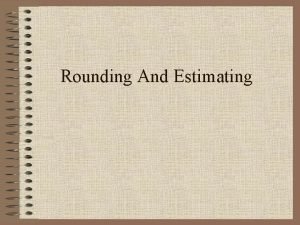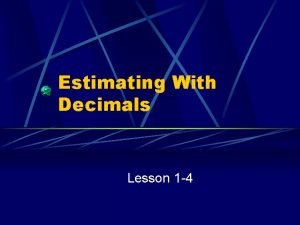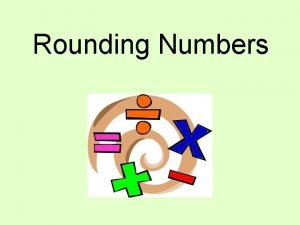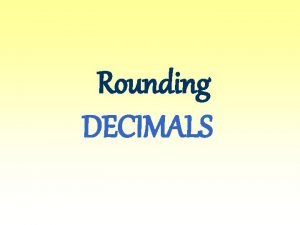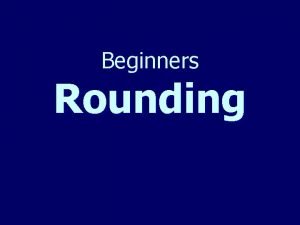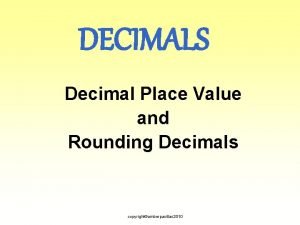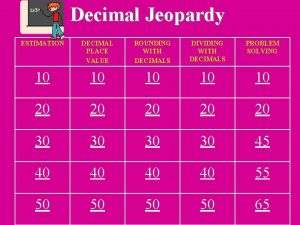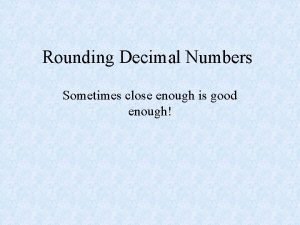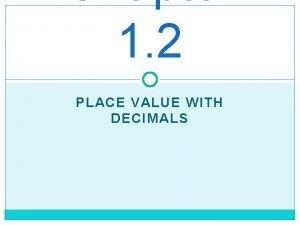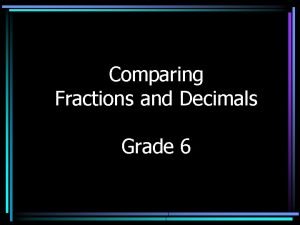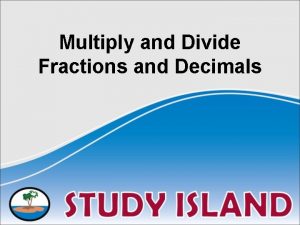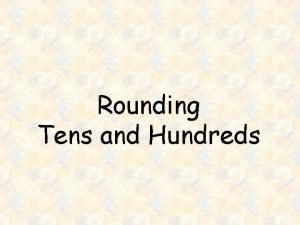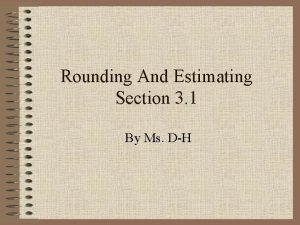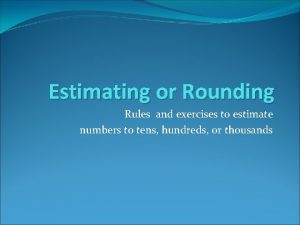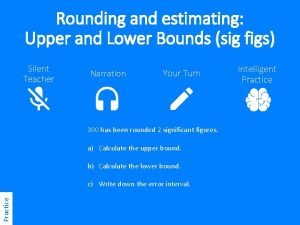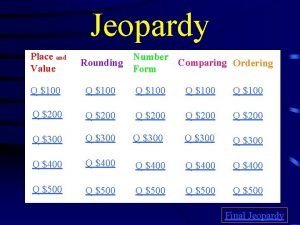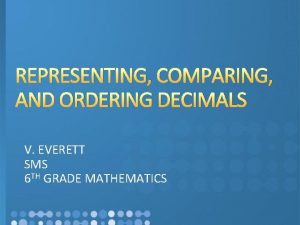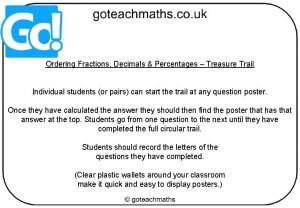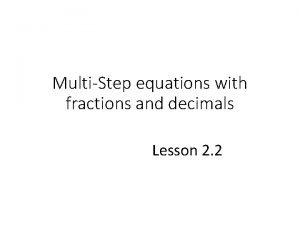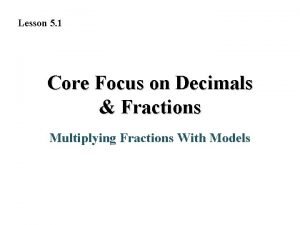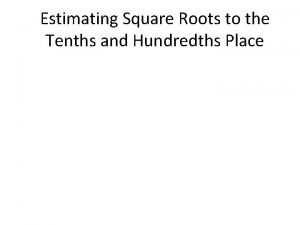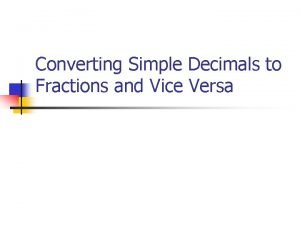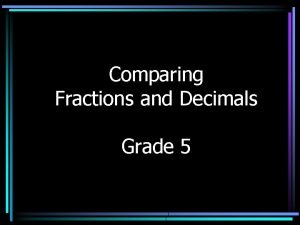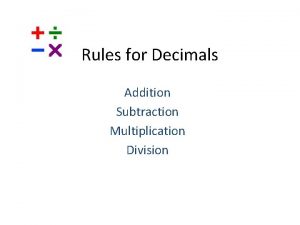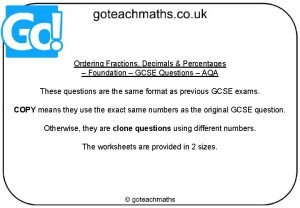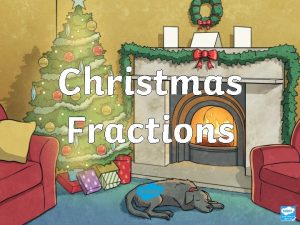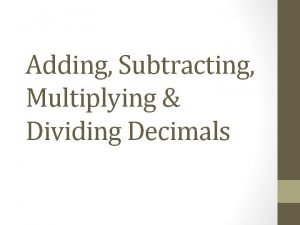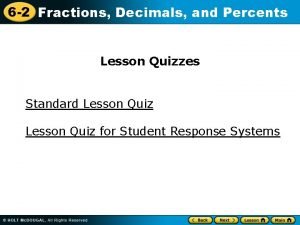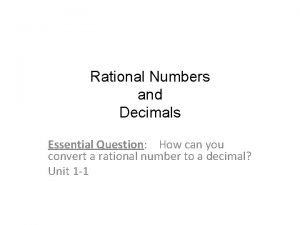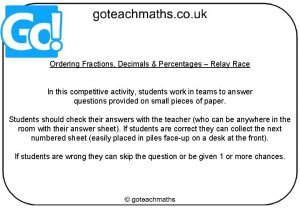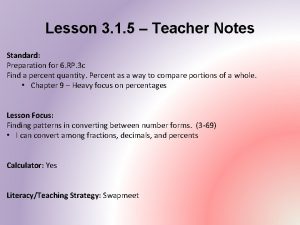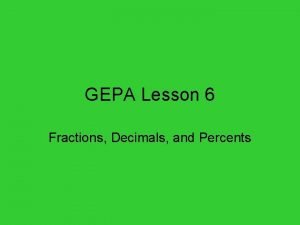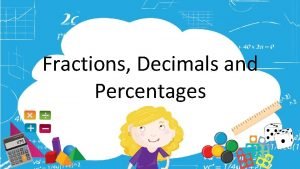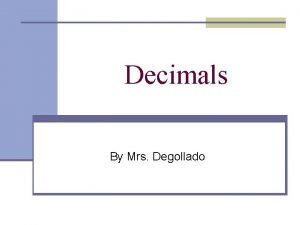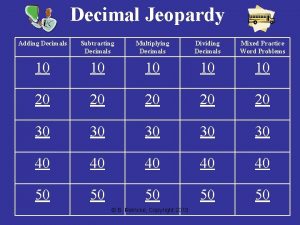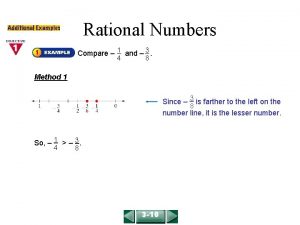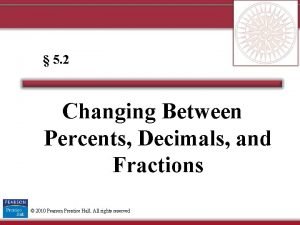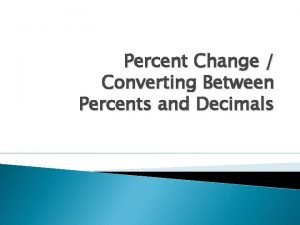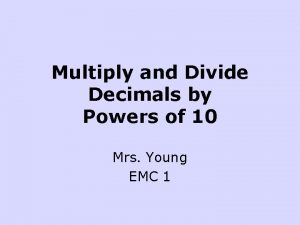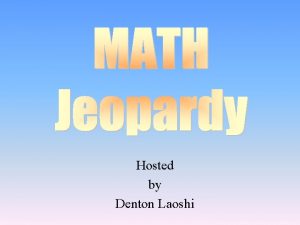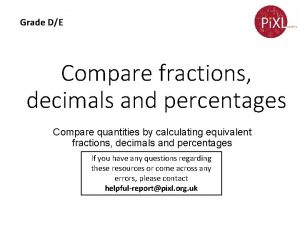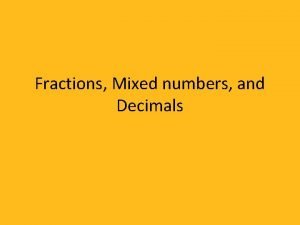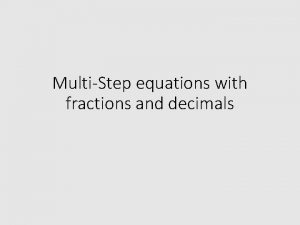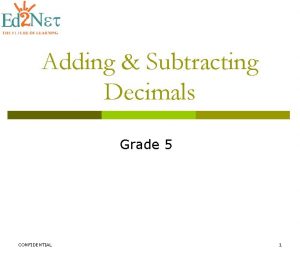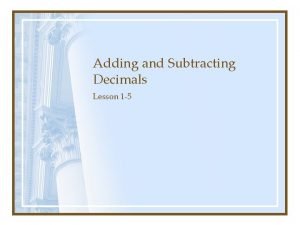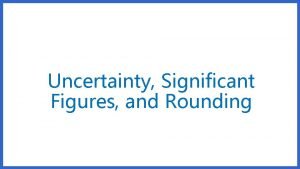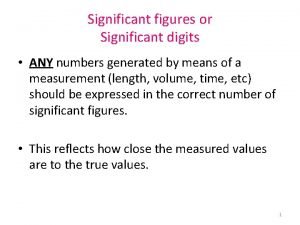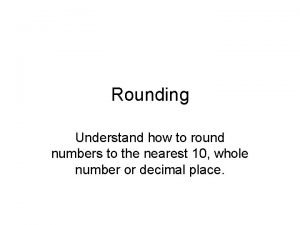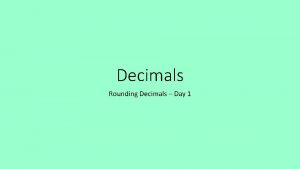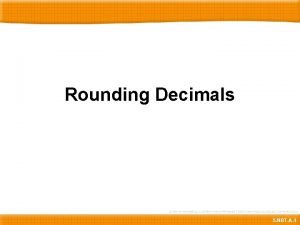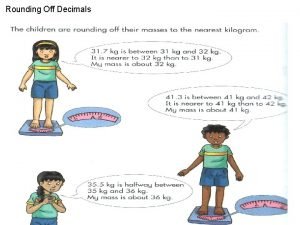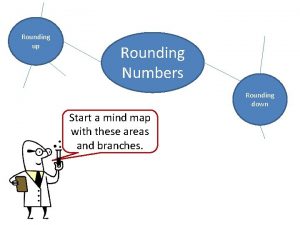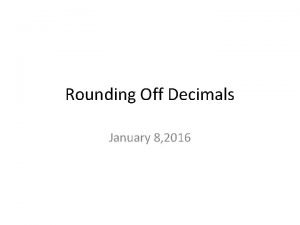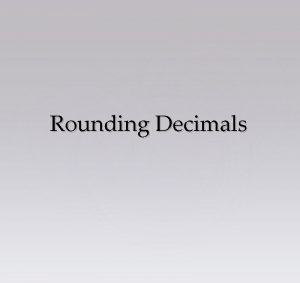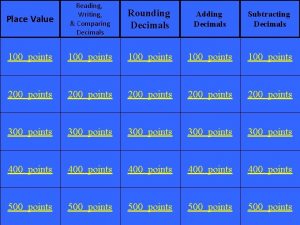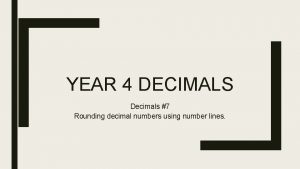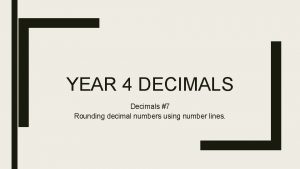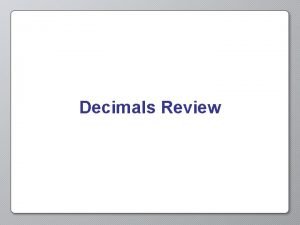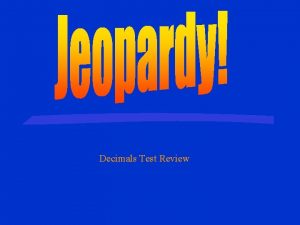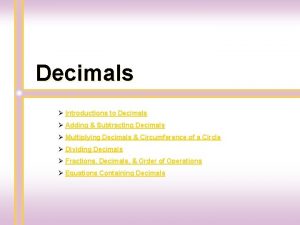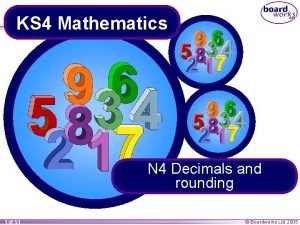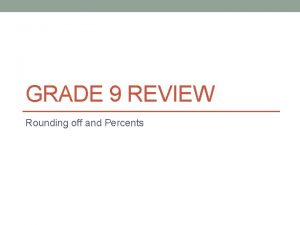KS 4 Mathematics N 4 Decimals and rounding





















































- Slides: 53

KS 4 Mathematics N 4 Decimals and rounding 1 of 53 © Boardworks Ltd 2005

Contents N 4 Decimals and rounding A N 4. 1 Decimals and place value A N 4. 2 Terminating and recurring decimals A N 4. 3 Calculating with decimals A N 4. 4 Rounding A N 4. 5 Upper and lower bounds 2 of 53 © Boardworks Ltd 2005

The decimal number system allows us to use the digits 0 to 9 and the place value system to represent numbers of any size. To represent whole numbers we label columns using increasing powers of 10: × 10 Te For example, 3 of 53 104 103 102 101 100 5 7 4 0 6 ts Un i Te ns s ed dr Hu n n Th th ou ou sa n sa ds nd s × 10 © Boardworks Ltd 2005

The decimal number system To represent fractions of whole numbers in our place value system we extend the column headings in the other direction by dividing by 10. Starting with the tens column we have: ÷ 10 s ÷ 10 For example, nd sa ed Th Hu n ou dr hs Te nt ts Un i Te ns th th s ÷ 10 101 100 10 -1 10 -2 10 -3 4 8 0 3 5 The decimal point 4 of 53 © Boardworks Ltd 2005

nd sa re Th ou nd Hu Te 102 101 100 10 -1 10 -2 10 -3 2 4 3 5 7 4 WHOLE NUMBER PART th hs dt s nt h its Un Te ns s re d nd Hu s The decimal number system DECIMAL PART The decimal point separates the whole number part from the fractional part. We can think of the number in this example as: 5 7 4 243. 574 = 200 + 40 + 3 + 1000 5 of 53 © Boardworks Ltd 2005

Contents N 4 Decimals and rounding A N 4. 1 Decimals and place value A N 4. 2 Terminating and recurring decimals A N 4. 3 Calculating with decimals A N 4. 4 Rounding A N 4. 5 Upper and lower bounds 6 of 53 © Boardworks Ltd 2005

Terminating decimals A terminating decimal is a decimal that has a fixed number of digits after the decimal point. For example, 0. 6, 0. 85 and 3. 536 Terminating decimals can be written as vulgar fractions by writing them over the appropriate power of 10 and canceling if possible. For example, 17 17 85 0. 85 = = 100 20 20 7 of 53 © Boardworks Ltd 2005

Recurring decimals 8 Convert into a decimal using your calculator. 11 A calculator displays this as: 0. 72727273 This decimal has been rounded to eight decimal places. The last digit is a 3 because it has been rounded up. The digits 2 and 7 actually repeat infinitely. This is an example of a recurring decimal. We can show this by writing dots above the 7 and the 2. . . 8 = 0. 72 11 8 of 53 © Boardworks Ltd 2005

Recurring decimals Here are some more examples of recurring decimals: . 4 = 0. 4 9 This decimal is made up of an infinite number of repeating 4’s. . 5 = 0. 83 6 This decimal starts with an 8 and is followed by an infinite number of repeating 3’s. . . In this decimal, the six digits 285714 repeat 2 = 0. 285714 7 an infinite number of times in the same order. . . 9 = 0. 409 22 9 of 53 This decimal starts with a 4. The two digits 09 then repeat an infinite number of times. © Boardworks Ltd 2005

Recurring decimals and fractions It is important to remember that all fractions convert to either terminating or recurring decimals. If the denominator of the fraction divides into a power of 10 then the fraction will convert into a terminating decimal. If the denominator of the fraction does not divide into a power of 10 then the fraction will convert into a recurring decimal. The converse is also true. All terminating and recurring decimals can be written as fractions in the form ab where a and b are integers and b ≠ 0. 10 of 53 © Boardworks Ltd 2005

Converting recurring decimals to fractions We can use place value to convert terminating decimals to fractions. Converting recurring decimals to fractions is more difficult. For example, Write 0. 88888… as a fraction. Start by letting the recurring decimal be equal to x. x = 0. 88888… One digit recurs so multiply both sides by 10. 10 x = 8. 88888… 11 of 53 © Boardworks Ltd 2005

Converting recurring decimals to fractions Write 0. 88888… as a fraction. Call these equations 1 and 2. x = 0. 88888… 1 10 x = 8. 88888… 2 Now, subtracting 1 from 2 we have, 9 x = 8 Dividing both sides of the equation by 9 we have, 8 x= 9 12 of 53 © Boardworks Ltd 2005

Converting recurring decimals to fractions Write 0. 63636… as a fraction. Let x = 0. 63636… 1 Two digits recur so multiply both sides by 100, 100 x = 63. 63636… 2 Now, subtracting 1 from 2 we have, 99 x = 63 Dividing both sides of the equation by 99 we have, 63 x= 99 13 of 53 7 11 7 = 11 © Boardworks Ltd 2005

Converting recurring decimals to fractions Write 0. 370370… as a fraction. Let x = 0. 370370… 1 Three digits recur so multiply both sides by 1000, 1000 x = 370370… 2 Now, subtracting 1 from 2 we have, 999 x = 370 Dividing both sides of the equation by 999 we have, 10 370 10 x= = 999 27 27 14 of 53 © Boardworks Ltd 2005

Nought point nine recurring The number 0. 99999… gives us an interesting result when we use this method to convert it into a fraction. x = 0. 99999… 1 10 x = 9. 99999… 2 Let Multiply both sides by 10, Now, subtracting 1 from 2 we have, 9 x = 9 Dividing both sides of the equation by 9 we have, x=1 0. 99999… is exactly equal to 1. 15 of 53 © Boardworks Ltd 2005

Rational numbers a b Any number that can be written in the form (where a and b are integers and b ≠ 0) is called a rational number. All of the following are rational: 6 7 7 – 12 . 0. 3 8 3 4 43. 721 All integers are rational because they can be written as the integer 1 We have seen that all terminating and recurring decimals a can be written as fractions in the form b. This means that they are also rational. 16 of 53 © Boardworks Ltd 2005

Irrational numbers Some numbers cannot be written in the form a b . These numbers are called irrational numbers. If we tried to write an irrational number as a decimal it would neither terminate nor recur. It would be represented by an infinite non-repeating string of digits. This means that irrational numbers can only be written as approximations to a given number of decimal places. Examples of irrational numbers include: π 17 of 53 √ 3 and sin 50° © Boardworks Ltd 2005

Rational or irrational? 18 of 53 © Boardworks Ltd 2005

Contents N 4 Decimals and rounding A N 4. 1 Decimals and place value A N 4. 2 Terminating and recurring decimals A N 4. 3 Calculating with decimals A N 4. 4 Rounding A N 4. 5 Upper and lower bounds 19 of 53 © Boardworks Ltd 2005

Adding and subtracting decimals 20 of 53 © Boardworks Ltd 2005

Short multiplication What is 2. 28 × 7? Start by finding an approximate answer: 2. 28 × 7 2 × 7 = 14 2. 28 × 7 is equivalent to 228 × 7 ÷ 100. 228 × 7 Answer 1596 2. 28 × 7 = 1596 ÷ 100= 15. 96 15 21 of 53 © Boardworks Ltd 2005

Short multiplication What is 392. 7 × 0. 8? Again, start by finding an approximate answer: 392. 7 × 0. 8 400 × 1 = 400 392. 7 × 0. 8 is equivalent to 3927 × 8 ÷ 100 3927 × 8 31416 72 5 22 of 53 Answer 392. 7 × 0. 8 = 31416 ÷ 100 = 314. 16 © Boardworks Ltd 2005

Long multiplication Calculate 57. 4 × 24 Estimate: 60 × 25 = 1500 Equivalent calculation: 57. 4 × 10 × 24 ÷ 10 = 574 × 24 ÷ 10 4 × 574 = 20 × 574 = 574 × 24 2296 11480 13776 Answer: 13776 ÷ 10 = 1377. 6 23 of 53 © Boardworks Ltd 2005

Long multiplication Calculate 23. 2 × 1. 8 Estimate: 23 × 2 = 46 Equivalent calculation: 23. 2 × 10 × 1. 8 × 10 ÷ 100 = 232 × 18 ÷ 100 8 × 232 = 10 × 232 × 18 1856 2320 4176 Answer: 4176 ÷ 100 = 41. 76 24 of 53 © Boardworks Ltd 2005

Long multiplication Calculate 394 × 0. 47 Estimate: 400 × 0. 5 = 200 Equivalent calculation: 394 × 0. 47 × 100 ÷ 100 = 394 × 47 ÷ 100 7 × 394 = 40 × 394 × 47 2758 15760 18518 Answer: 18518 ÷ 100 = 185. 18 25 of 53 © Boardworks Ltd 2005

Long multiplication 26 of 53 © Boardworks Ltd 2005

Short division Calculate 259. 2 ÷ 6 Start by finding an approximate answer: 259. 2 ÷ 6 240 ÷ 6 = 40 043. 2 6 22519. 12 259. 2 ÷ 6 = 43. 2 27 of 53 © Boardworks Ltd 2005

Short division by a decimal Calculate 57. 23 ÷ 0. 8 to 2 decimal places. When we are asked to divide by a decimal we should first write an equivalent calculation with a whole number divider. × 10 57. 23 0. 8 = 572. 3 8 × 10 We can then find an approximate answer: 572. 3 ÷ 8 ≈ 560 ÷ 8 = 70 28 of 53 © Boardworks Ltd 2005

Short division by a decimal Calculate 57. 23 ÷ 0. 8 to 2 decimal places. We are dividing by a single digit and so it is most efficient to use short division: 07 1. 5 3 7 8 55712. 433060 We need to find the value of this digit to see whether we need to round up or down. 57. 23 ÷ 0. 8 = 71. 54 (to 2 d. p. ) 29 of 53 © Boardworks Ltd 2005

Dividing by two-digit numbers Calculate 75. 4 ÷ 3. 1 Estimate: 75 ÷ 3 = 25 Equivalent calculation: 75. 4 ÷ 3. 1 = 754 ÷ 31 31 754 - 620 134 - 124 10. 0 - 9. 3 0. 70 - 0. 62 0. 08 20 × 31 4 × 31 0. 3 × 31 0. 02 × 31 Answer: 75. 4 ÷ 3. 1 = 24. 32 R 0. 08 = 24. 3 to 1 d. p. 30 of 53 © Boardworks Ltd 2005

Dividing by two-digit numbers Calculate 8. 12 ÷ 0. 46 Estimate: 8 ÷ 0. 5 = 16 Equivalent calculation: 8. 12 ÷ 0. 46 = 812 ÷ 46 46 812 - 460 352 - 322 30. 0 - 27. 6 2. 40 - 2. 30 0. 10 10 × 46 7 × 46 0. 6 × 46 0. 05 × 46 Answer: 8. 12 ÷ 0. 43 = 17. 65 R 0. 1 = 17. 7 to 1 d. p. 31 of 53 © Boardworks Ltd 2005

Long division 32 of 53 © Boardworks Ltd 2005

Contents N 4 Decimals and rounding A N 4. 1 Decimals and place value A N 4. 2 Terminating and recurring decimals A N 4. 3 Calculating with decimals A N 4. 4 Rounding A N 4. 5 Upper and lower bounds 33 of 53 © Boardworks Ltd 2005

Rounding We do not always need to know the exact value of a number. For example, There are 1432 pupils at Eastpark Secondary School. There about one and a half thousand pupils at Eastpark Secondary School. 34 of 53 © Boardworks Ltd 2005

Rounding There are four main ways of rounding a number: 1) To the nearest 10, 1000, or other power of ten. 2) To the nearest whole number. 3) To a given number of decimal places. 4) To a given number of significant figures. The method of rounding used usually depends on what kind of numbers we are dealing with. Whole numbers, for example, can be rounded to the nearest power of ten or to a given number of significant figures. 35 of 53 © Boardworks Ltd 2005

Rounding to powers of ten 36 of 53 © Boardworks Ltd 2005

Rounding to powers of ten Example Round 34 871 to the nearest 100. Look at the digit in the hundreds position. We need to write down every digit up to this. Look at the digit in the tens position. If this digit is 5 or more then we need to round up the digit in the hundreds position. Solution: 37 of 53 34871 = 34900 (to the nearest 100) © Boardworks Ltd 2005

Rounding to powers of ten Complete this table: to the nearest 1000 to the nearest 10 37521 38000 37520 274503 275000 274500 7630918 7631000 7630920 9875 10000 9900 9880 452 0 500 450 38 of 53 © Boardworks Ltd 2005

Rounding to decimal places 39 of 53 © Boardworks Ltd 2005

Rounding to decimal places Example Round 2. 75241302 to one decimal place. Look at the digit in the first decimal place. We need to write down every digit up to this. Look at the digit in the second decimal place. If this digit is 5 or more then we need to round up the digit in the first decimal place. 2. 75241302 to 1 decimal place is 2. 8. 40 of 53 © Boardworks Ltd 2005

Rounding to decimal places Complete this table: to the nearest whole number to 1 d. p. to 2 d. p. to 3 d. p. 63. 4721 63 63. 5 63. 472 87. 6564 88 87. 7 87. 66 87. 656 149. 9875 150. 0 149. 99 149. 988 3. 54029 4 3. 540 0. 59999 1 0. 600 41 of 53 © Boardworks Ltd 2005

Rounding to significant figures Numbers can also be rounded to a given number of significant figures. The first significant figure of a number is the first digit which is not a zero. For example, 4 890 351 This is the first significant figure and 0. 0007506 This is the first significant figure 42 of 53 © Boardworks Ltd 2005

Rounding to significant figures The second, third and fourth significant figures are the digits immediately following the first significant figure, including zeros. For example, 4 890 351 This is the first significant figure This is is the isthe second third fourth significant figure and 0. 0007506 This is first significant figure This isthe second significant figure This is isthe third fourth significant figure 43 of 53 © Boardworks Ltd 2005

Rounding to significant figures Complete this table: to 3 s. f. to 2 s. f. to 1 s. f. 6. 3528 6. 35 6. 4 6 34. 026 34. 0 34 30 0. 005708 0. 00571 0. 0057 0. 006 150. 932 151 150 200 0. 0000784 0. 00007835 44 of 53 © Boardworks Ltd 2005

Contents N 4 Decimals and rounding A N 4. 1 Decimals and place value A N 4. 2 Terminating and recurring decimals A N 4. 3 Calculating with decimals A N 4. 4 Rounding A N 4. 5 Upper and lower bounds 45 of 53 © Boardworks Ltd 2005

Discrete and continuous quantities Numerical data can be discrete or continuous. Discrete data can only take certain values. For example, shoe sizes, the number of children in a class, amounts of money Continuous data comes from measuring and can take any value within a given range. For example, the weight of a banana, the time it takes for pupils to get to school, heights of 15 year-olds. 46 of 53 © Boardworks Ltd 2005

Upper and lower bounds for discrete data The population of the United Kingdom is 59 million to the nearest million. What is the least this number could be? The least this number could be before being rounded up is: 58 500 000 What is the most this number could be? The most this number could be before being rounded down is: 59 499 999 47 of 53 © Boardworks Ltd 2005

Upper and lower bounds We can give the possible range for the population as: 58 500 000 ≤ population ≤ 59 499 999 This value is called the lower bound … … and this value is called the upper bound. This is an inequality. It says that the actual population of the United Kingdom is between 58 500 000 and 59 499 999. Because we have used ≤ symbols it means that these two numbers are included in the range of possible values. We could also write the range as: 58 500 000 ≤ population < 59 500 000 48 of 53 © Boardworks Ltd 2005

Upper and lower bounds for discrete data Last year a shopkeeper made a profit of £ 43 250, to the nearest £ 50. What range of values could this amount be in? The lower bound is half-way between £ 43 200 and £ 43 250: £ 43 225 The upper bound is half-way between £ 43 250 and £ 43 300, minus 1 p: £ 43 274. 99 The range for this profit is: £ 43 225 ≤ profit ≤ £ 43 274. 99 49 of 53 © Boardworks Ltd 2005

Upper and lower bounds for discrete data 50 of 53 © Boardworks Ltd 2005

Upper and lower bounds for continuous data The height of the Eiffel Tower is 324 meters to the nearest meter. What is the least this measurement could be? The least this measurement could be before being rounded up is: 323. 5 m What is the most this measurement could be? The most this measurement could be before being rounded down is up to but not including: 324. 5 m 51 of 53 © Boardworks Ltd 2005

Upper and lower bounds We can write the range for this measurement as: 323. 5 m ≤ height < 324. 5 m This value is called the lower bound … … and this value is called the upper bound. The height could be equal to 323. 5 m so we use a greater than or equal to symbol. If the length was equal to 324. 5 m however, it would have been rounded up to 325 m. The length is therefore “strictly less than” 324. 5 m and so we use the < symbol. 52 of 53 © Boardworks Ltd 2005

Upper and lower bounds 53 of 53 © Boardworks Ltd 2005
 Cluster estimation with decimals
Cluster estimation with decimals Rounding and estimating decimals
Rounding and estimating decimals Rules for rounding decimals
Rules for rounding decimals Hundredths place rounding
Hundredths place rounding Rounding off poem
Rounding off poem Ten thousandths place
Ten thousandths place Jeopardy decimal place value
Jeopardy decimal place value Decimal poem
Decimal poem Rounding decimals jeopardy
Rounding decimals jeopardy Rounding decimals jeopardy
Rounding decimals jeopardy Comparing fractions and decimals
Comparing fractions and decimals Dividing fractions with decimals
Dividing fractions with decimals Compare
Compare Pico question for falls and hourly rounding
Pico question for falls and hourly rounding Rounding key words
Rounding key words Front-end rounding
Front-end rounding Estimate and rounding
Estimate and rounding How to find upper and lower bounds of significant figures
How to find upper and lower bounds of significant figures Rounding jeopardy
Rounding jeopardy Representing comparing and ordering decimals
Representing comparing and ordering decimals Ordering fractions decimals and percents
Ordering fractions decimals and percents Multi step equations fractions
Multi step equations fractions Lesson 5 decimals and fractions
Lesson 5 decimals and fractions Roots of decimals and fractions
Roots of decimals and fractions Changing decimals to fractions and vice versa
Changing decimals to fractions and vice versa Compare fractions and decimals
Compare fractions and decimals Rule for adding decimals
Rule for adding decimals Fractions decimals and percentages gcse
Fractions decimals and percentages gcse Christmas decimals and fractions
Christmas decimals and fractions Add subtract multiply and divide decimals worksheet
Add subtract multiply and divide decimals worksheet 6-2 relate fractions decimals and percents
6-2 relate fractions decimals and percents How are rational numbers written as decimals
How are rational numbers written as decimals Greatest to least fraction
Greatest to least fraction Lesson 3 percents and decimals
Lesson 3 percents and decimals Two sevenths as a decimal
Two sevenths as a decimal Lesson 6-2 fractions, decimals, and percents answers
Lesson 6-2 fractions, decimals, and percents answers Examples of fractions in everyday life
Examples of fractions in everyday life Dividing decimals foldable
Dividing decimals foldable Adding and subtracting decimals jeopardy
Adding and subtracting decimals jeopardy Lesson 3-1 rational numbers and decimals
Lesson 3-1 rational numbers and decimals Converting between percents decimals and fractions
Converting between percents decimals and fractions Converting between percents decimals and fractions
Converting between percents decimals and fractions Multiplying and dividing decimals by powers of 10
Multiplying and dividing decimals by powers of 10 Fractions decimals and percents calculator
Fractions decimals and percents calculator Compare fractions decimals and percentages
Compare fractions decimals and percentages Mixed number to decimal
Mixed number to decimal Equations with variables on both sides decimals & fractions
Equations with variables on both sides decimals & fractions Adding and subtracting decimals jeopardy
Adding and subtracting decimals jeopardy Adding and subtracting decimals jeopardy
Adding and subtracting decimals jeopardy Uncertainty significant figures
Uncertainty significant figures Stochastic rounding
Stochastic rounding Sig fig rules
Sig fig rules Rounding starter
Rounding starter Ten thousand
Ten thousand
